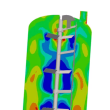Project
Our Project
General Project Description
The goal of the project "Novel Exascale Architectures with Heterogeneous Hardware Components for Flow Simulations - StroemungsRaum®" (short: StroemungsRaum®) is to extend the scalability of the user solution StroemungsRaum®, which has been successfully used by the SME IANUS Simulation as Simulation-as-a-Service in the industrial environment for many years. The simulation core of the StroemungsRaum® platform, the open-source software FEATFLOW, is to be expanded so that highly scalable CFD simulations can be carried out efficiently and quickly on future exascale architectures with heterogeneous hardware components. Significantly more complex and finely resolved CFD simulations in industrial application should thus maintain and further increase the innovative power at the German location, especially in the plastics, pharmaceutical and food industries. By combining the leading methodological approaches for efficient, parallel solution of CFD problems with a consistent, stringent application of performance engineering, IANUS Simulation with StroemungsRaum® should be sustainably enabled to maintain its leading role in the field of industry-specific CFD solutions considered here, especially in the plastics sector, and even expand it internationally.
The scalability and efficiency of the FEATFLOW software at the core of StroemungsRaum® will be significantly improved by new algorithms and made exascale-capable through co-design between algorithms and sustainable performance engineering. To ensure optimal use of future exascale architectures with heterogeneous hardware components, new geometric multigrid solvers for accelerator hardware and highly scalable nonlinear domain decomposition methods for CPU and GPU are being developed. Complex and finely resolved geometries are enabled by the connection of algebraic multilevel methods. Various time-parallel/time-simultaneous approaches will increase the parallel potential of the algorithms, while nonlinear domain decomposition methods will accelerate nonlinear convergence in a parallel scalable way and allow for larger time steps. Taken together, these approaches will sustainably reduce computational time. The performance engineering, in co-design with the method development, considers both node-level performance and global communication patterns, thus improving the (energy-)efficient use of the hardware by the user software StroemungsRaum®.
The methods developed in this project can be made available to IANUS customers almost immediately, thanks to its design as a Software-as-a-Service, which will therefore directly benefit from the results of this project. Moreover, the improvements to StroemungsRaum® enable the opening up of new application circles, as only then new requirements for response time and accuracy of the simulations can be met. The project expands and consolidates the know-how for future exascale systems and methods at research institutions and universities. This benefits both further research and teaching, directly through final theses and indirectly through the integration of the content into further events. The software FEATFLOW is already used as an open-source solution at various universities and with the improvements achieved through this project, it will also enable research and teaching regarding exascale methods. Based on the successful application of the Gauss Center for Supercomputing with Jülich as the location for the first European exascale supercomputer, the partners will also create the foundation for the formation of a German exascale community in the field of fluid simulations through this project.
Our Team
Project Partners













